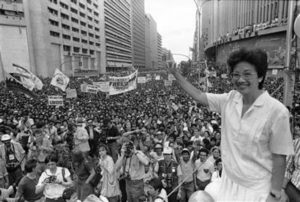EDSA is a name that has become synonymous with two things: the hectic and slow traffic that has become commonplace in Metro Manila these days, and the revolution that finally ended Dictator Ferdinand Marcos’ regime in the country. Last February 25, we celebrated the 34th anniversary of this historic and proud moment for us Filipinos, where Filipinos of all ages and walks of life united in a peaceful demonstration showing their opposition for the Marcos regime. The “People Power Revolution”, as it became known, showed the world what Filipinos can do as a united nation.
Origins of the EDSA revolution
But how did this happen? To answer this question, we need to go back to a few days before February 25, when Pres. Marcos declared himself the winner of the 1986 snap elections on February 20. This snap election came to be because of the people becoming less supportive of the regime. Marcos needed to show his strongest ally, the US, that he still has the people’s support and his regime is not falling into chaos.
In spite of Marcos’ supposed electoral victory, his opponent, Cory Aquino, held a victory rally in Luneta and urged Filipinos to do civil disobedience. A few days after this, members of the military, led by Defense Minister Juan Ponce-Enrile and Philippine Constabulary (Police) Chief Lt.Gen. Fidel Ramos, planned to stage a coup against Pres. Marcos and eventually allied themselves to Cory Aquino. They were situated at Camp Aguinaldo and was preparing to attack Malacañang Palace when they were found out by government forces and government troops were sent there to put a stop to their coup.
The People March on EDSA

While this was happening, Manila Archbishop Jaime Cardinal Sin, through radio Veritas, urged Filipinos to show their support to Enrile and Ramos. The two groups met in EDSA where Filipinos were gathering in greater numbers. Marcos’ forces erected barricades and deployed tanks and armed troops in order to invade Camp Aguinaldo but ordinary Filipinos with nothing but flowers and rosaries stood in their path. The protestors held demonstrations calling for the removal of the Marcos regime and the restoration of democracy amidst the tanks and armed troops while urging government troops to lay down their arms and join the protesters.
Marcos Falls

The next day, February 24, even more people flocked to
EDSA, and began to fill Greenhills, San Juan, Ortigas, Libis, and Cubao, near
Crame to show their support and protection to growing movement. Rumors that the
Marcos family left Malacañang began to circle around amongst the people but
were quashed when Marcos appeared before national television and stressed that
he and his family would not be leaving Malacañang. Alongside this, the US
withdrew its support from Marcos and turned its support to Cory Aquino’s new
government.
On February 25, Cory Aquino and her running mate Salvador Laurel were sworn in by Senior Associate Justice Claudio Teehankee and Supreme Court Justice Vicente Abad Santos respectively, Marcos was also sworn in an hour later but the live coverage was abruptly cut. Later that evening, amidst shelling by Enrile and Ramos’ troops, Marcos and his family departed Malacañang and fled to Hawaii. With their departure, democracy finally returned to the Philippines with a new government.
Sources:
EDSA People Power Revolution. (n.d.). Retrieved February 26, 2020, from https://www.philippine-history.org/edsa-people-power-revolution.htm
News, A. B. S.-C. B. N. (2017, February 21). TIMELINE: EDSA People Power Revolution. Retrieved February 26, 2020, from https://news.abs-cbn.com/focus/02/21/17/timeline- edsa-people-power-revolution


